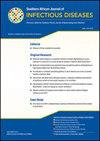COVID-19 在南非开普敦一家三级医疗中心的性质变化和影响减弱
IF 1.3
Q4 INFECTIOUS DISEASES
引用次数: 0
摘要
背景:在基于人群的研究中,SARS-CoV-2 基因变异体的出现与 2019 年冠状病毒病(COVID-19)大流行期间流行病学特征的变化有关。关于非洲国家感染不同SARS-CoV-2变体的临床特征的个人层面数据记录较少:目的:描述所观察到的不同 SARS-CoV-2 变体在临床上的演变差异,并将 Omicron 驱动的感染浪潮与之前的 Delta 驱动的感染浪潮进行比较:我们对南非一家转诊医院收治的 COVID-19 肺炎患者进行了一项回顾性观察队列研究。根据流行病学波段对患者进行了分层,并通过基因组测序确认了与每个波段相关的变异。结果采用 Cox 比例危险模型进行分析:我们共纳入了 1689 名患者,他们代表了主要由祖先、Beta、Delta 和 Omicron BA1/BA2 BA4/BA5 变体驱动的感染波。在 Omicron 波段中,28 天的粗死亡率为 25.8%(34/133),而在 Delta 波段中,死亡率为 37.1%(138/374)(危险比 [HR] 0.68 [95% CI 0.47-1.00] p = 0.049);在对年龄、性别、HIV 感染状况和是否患有心血管疾病进行调整后,这一效应依然存在(调整后 HR [aHR] 0.43 [95% CI 0.28-0.67] p 0.001)。在德尔塔波期间,全院 SARS-CoV-2 入院人数和死亡人数最高,此后 SARS-CoV-2 死亡人数与总体死亡人数脱钩:结论:与之前的德尔塔波相比,欧米茄波期间的院内死亡率较低,尽管欧米茄波期间入院的患者风险较高:本研究总结了南非一家三甲医院在 COVID-19 大流行期间与 SARS-CoV-2 变体相关的临床特征,表明尽管新变体引发了流行浪潮,但随着时间的推移,COVID-19 对医疗服务的影响在逐渐减弱。研究结果表明,后期变种的毒力并没有增强,而人群和个人的免疫力则起到了保护作用。本文章由计算机程序翻译,如有差异,请以英文原文为准。
Changing character and waning impact of COVID-19 at a tertiary centre in Cape Town, South Africa
Background: The emergence of genetic variants of SARS-CoV-2 was associated with changing epidemiological characteristics throughout coronavirus disease 2019 (COVID-19) pandemic in population-based studies. Individual-level data on the clinical characteristics of infection with different SARS-CoV-2 variants in African countries is less well documented.Objectives: To describe the evolving clinical differences observed with the various SARS-CoV-2 variants of concern and compare the Omicron-driven wave in infections to the previous Delta-driven wave.Method: We performed a retrospective observational cohort study among patients admitted to a South African referral hospital with COVID-19 pneumonia. Patients were stratified by epidemiological wave period, and in a subset, the variants associated with each wave were confirmed by genomic sequencing. Outcomes were analysed by Cox proportional hazard models.Results: We included 1689 patients were included, representing infection waves driven predominantly by ancestral, Beta, Delta and Omicron BA1/BA2 BA4/BA5 variants. Crude 28-day mortality was 25.8% (34/133) in the Omicron wave period versus 37.1% (138/374) in the Delta wave period (hazard ratio [HR] 0.68 [95% CI 0.47–1.00] p = 0.049); this effect persisted after adjustment for age, gender, HIV status and presence of cardiovascular disease (adjusted HR [aHR] 0.43 [95% CI 0.28–0.67] p 0.001). Hospital-wide SARS-CoV-2 admissions and deaths were highest during the Delta wave period, with a decoupling of SARS-CoV-2 deaths and overall deaths thereafter.Conclusion: There was lower in-hospital mortality during Omicron-driven waves compared with the prior Delta wave, despite patients admitted during the Omicron wave being at higher risk.Contribution: This study summarises clinical characteristics associated with SARS-CoV-2 variants during the COVID-19 pandemic at a South African tertiary hospital, demonstrating a waning impact of COVID-19 on healthcare services over time despite epidemic waves driven by new variants. Findings suggest the absence of increasing virulence from later variants and protection from population and individual-level immunity.
求助全文
通过发布文献求助,成功后即可免费获取论文全文。
去求助
来源期刊

Southern African Journal of Infectious Diseases
INFECTIOUS DISEASES-
自引率
11.10%
发文量
50
审稿时长
52 weeks
 求助内容:
求助内容: 应助结果提醒方式:
应助结果提醒方式:


